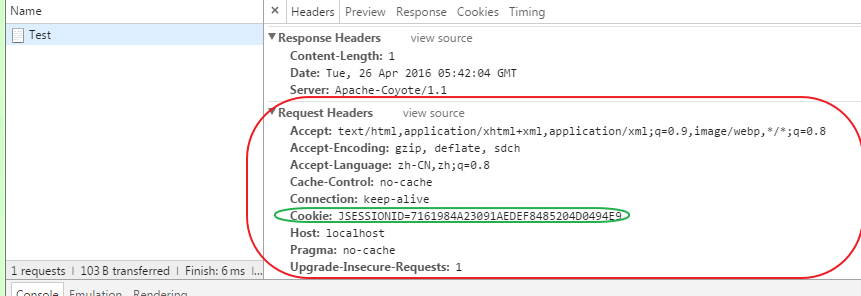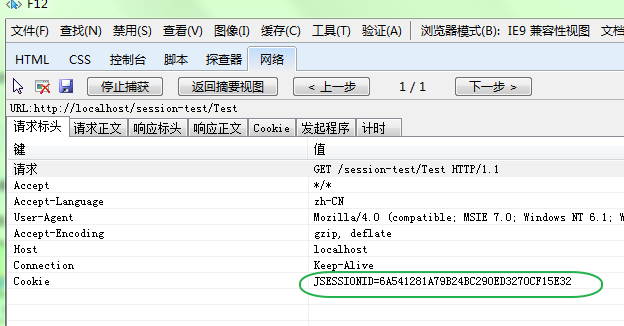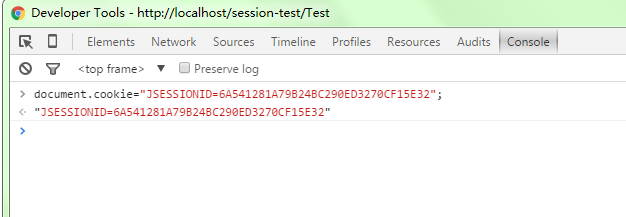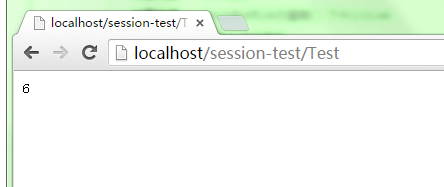[转]Tomcat中的Session小结
什么是Session
对Tomcat而言,Session是一块在服务器开辟的内存空间,其存储结构为ConcurrentHashMap;
Session的目的
Http协议是一种无状态协议,即每次服务端接收到客户端的请求时,都是一个全新的请求,服务器并不知道客户端的历史请求记录;
Session的主要目的就是为了弥补Http的无状态特性。简单的说,就是服务器可以利用session存储客户端在同一个会话期间的一些操作记录;
实现机制
先看两个问题,如下:
1、服务器如何判断客户端发送过来的请求是属于同一个会话?
答:用Session id区分,Session id相同的即认为是同一个会话,在Tomcat中Session id用JSESSIONID表示;
2、服务器、客户端如何获取Session id?Session id在其之间是如何传输的呢?
答:服务器第一次接收到请求时,开辟了一块Session空间(创建了Session对象),同时生成一个Session id,并通过响应头的Set-Cookie:“JSESSIONID=XXXXXXX”命令,向客户端发送要求设置cookie的响应;
客户端收到响应后,在本机客户端设置了一个JSESSIONID=XXXXXXX的cookie信息,该cookie的过期时间为浏览器会话结束;
接下来客户端每次向同一个网站发送请求时,请求头都会带上该cookie信息(包含Session id);
然后,服务器通过读取请求头中的Cookie信息,获取名称为JSESSIONID的值,得到此次请求的Session id;
ps:服务器只会在客户端第一次请求响应的时候,在响应头上添加Set-Cookie:“JSESSIONID=XXXXXXX”信息,接下来在同一个会话的第二第三次响应头里,是不会添加Set-Cookie:“JSESSIONID=XXXXXXX”信息的;
而客户端是会在每次请求头的cookie中带上JSESSIONID信息;
举个例子:
以chrome浏览器为例,访问一个基于tomcat服务器的网站的时候,
浏览器第一次访问服务器,服务器会在响应头添加Set-Cookie:“JSESSIONID=XXXXXXX”信息,要求客户端设置cookie,如下图:

同时我们也可以在浏览器中找到其存储的sessionid信息,如下图

接下来,浏览器第二次、第三次...访问服务器,观察其请求头的cookie信息,可以看到JSESSIONID信息存储在cookie里,发送给服务器;且响应头里没有Set-Cookie信息,如下图:

只要浏览器未关闭,在访问同一个站点的时候,其请求头Cookie中的JSESSIONID都是同一个值,被服务器认为是同一个会话。
再举个简单的例子加深印象,新建个Web工程,并写一个Servlet,在doGet中添加如下代码,主要做如下工作
首先,从session中获取key为count的值,累加,存入session,并打印;
然后,每次从请求中获取打印cookie信息,从响应中获取打印Header的Set-Cookie信息:

/**
* @see HttpServlet#doGet(HttpServletRequest request, HttpServletResponse response)
*/
protected void doGet(HttpServletRequest request, HttpServletResponse response) throws ServletException, IOException { if(request.getSession().getAttribute("count") == null){
request.getSession().setAttribute("count", 0);
response.getWriter().write(0+"");
}else{
int a = Integer.parseInt(request.getSession().getAttribute("count").toString());
request.getSession().setAttribute("count", ++a);
response.getWriter().write(a+"");
} Cookie[] cookies = request.getCookies();
StringBuffer sb = new StringBuffer();
if(cookies!=null){
for(Cookie cookie : cookies){
sb.append(cookie.getName()+":"+cookie.getValue()+",");
}
sb.deleteCharAt(sb.length()-1);
} System.out.println("[第"+(++index)+"次访问]from client request, cookies:" + sb);
System.out.println("[第"+(index)+"次访问]from server response, header-Set-Cookie:" + response.getHeader("Set-Cookie"));;
}

部署到tomcat后,连续访问该servlet,观察控制台输出,如下,客户端第一次访问服务器的时候,在服务端的响应头里添加了JSESSIONID信息,且接下来客户端的每次访问都会带上该JSESSIONID:

其实这里有一个问题,session劫持
只要用户知道JSESSIONID,该用户就可以获取到JSESSIONID对应的session内容,还是以上面这个例子为例,
我先用IE浏览器访问该站点,比如连续访问了5次,此时,session中的count值为:

查看该会话的Session id,为6A541281A79B24BC290ED3270CF15E32

接下来打开chrome控制台,将IE浏览器获取过来的JSESSIONID信息(“6A541281A79B24BC290ED3270CF15E32”)写入到cookie中,如下

接着删除其中的一个,只留下JSESSIONID为“6A541281A79B24BC290ED3270CF15E32”的cookie;

刷新页面,发现我们从session获取的count值已经变成6了,说明此次chrome浏览器的请求劫持了IE浏览器会话中的session,

Tomcat中的session实现
Tomcat中一个会话对应一个session,其实现类是StandardSession,查看源码,可以找到一个attributes成员属性,即存储session的数据结构,为ConcurrentHashMap,支持高并发的HashMap实现;
/**
* The collection of user data attributes associated with this Session.
*/
protected Map<String, Object> attributes = new ConcurrentHashMap<String, Object>();
那么,tomcat中多个会话对应的session是由谁来维护的呢?ManagerBase类,查看其代码,可以发现其有一个sessions成员属性,存储着各个会话的session信息:
/**
* The set of currently active Sessions for this Manager, keyed by
* session identifier.
*/
protected Map<String, Session> sessions = new ConcurrentHashMap<String, Session>();
接下来,看一下几个重要的方法,
服务器查找Session对象的方法
客户端每次的请求,tomcat都会在HashMap中查找对应的key为JSESSIONID的Session对象是否存在,可以查看Request的doGetSession方法源码,如下源码:

protected Session doGetSession(boolean create) {
// There cannot be a session if no context has been assigned yet
Context context = getContext();
if (context == null) {
return (null);
}
// Return the current session if it exists and is valid
if ((session != null) && !session.isValid()) {
session = null;
}
if (session != null) {
return (session);
}
// Return the requested session if it exists and is valid
Manager manager = context.getManager();
if (manager == null) {
return null; // Sessions are not supported
}
if (requestedSessionId != null) {
try {
session = manager.findSession(requestedSessionId);
} catch (IOException e) {
session = null;
}
if ((session != null) && !session.isValid()) {
session = null;
}
if (session != null) {
session.access();
return (session);
}
}
// Create a new session if requested and the response is not committed
if (!create) {
return (null);
}
if ((context != null) && (response != null) &&
context.getServletContext().getEffectiveSessionTrackingModes().
contains(SessionTrackingMode.COOKIE) &&
response.getResponse().isCommitted()) {
throw new IllegalStateException
(sm.getString("coyoteRequest.sessionCreateCommitted"));
}
// Re-use session IDs provided by the client in very limited
// circumstances.
String sessionId = getRequestedSessionId();
if (requestedSessionSSL) {
// If the session ID has been obtained from the SSL handshake then
// use it.
} else if (("/".equals(context.getSessionCookiePath())
&& isRequestedSessionIdFromCookie())) {
/* This is the common(ish) use case: using the same session ID with
* multiple web applications on the same host. Typically this is
* used by Portlet implementations. It only works if sessions are
* tracked via cookies. The cookie must have a path of "/" else it
* won't be provided to for requests to all web applications.
*
* Any session ID provided by the client should be for a session
* that already exists somewhere on the host. Check if the context
* is configured for this to be confirmed.
*/
if (context.getValidateClientProvidedNewSessionId()) {
boolean found = false;
for (Container container : getHost().findChildren()) {
Manager m = ((Context) container).getManager();
if (m != null) {
try {
if (m.findSession(sessionId) != null) {
found = true;
break;
}
} catch (IOException e) {
// Ignore. Problems with this manager will be
// handled elsewhere.
}
}
}
if (!found) {
sessionId = null;
}
sessionId = getRequestedSessionId();
}
} else {
sessionId = null;
}
session = manager.createSession(sessionId);
// Creating a new session cookie based on that session
if ((session != null) && (getContext() != null)
&& getContext().getServletContext().
getEffectiveSessionTrackingModes().contains(
SessionTrackingMode.COOKIE)) {
Cookie cookie =
ApplicationSessionCookieConfig.createSessionCookie(
context, session.getIdInternal(), isSecure());
response.addSessionCookieInternal(cookie);
}
if (session == null) {
return null;
}
session.access();
return session;
}

先看doGetSession方法中的如下代码,这个一般是第一次访问的情况,即创建session对象,session的创建是调用了ManagerBase的createSession方法来实现的; 另外,注意response.addSessionCookieInternal方法,该方法的功能就是上面提到的往响应头写入“Set-Cookie”信息;最后,还要调用session.access方法记录下该session的最后访问时间,因为session是可以设置过期时间的;

session = manager.createSession(sessionId);
// Creating a new session cookie based on that session
if ((session != null) && (getContext() != null)
&& getContext().getServletContext().
getEffectiveSessionTrackingModes().contains(
SessionTrackingMode.COOKIE)) {
Cookie cookie =
ApplicationSessionCookieConfig.createSessionCookie(
context, session.getIdInternal(), isSecure());
response.addSessionCookieInternal(cookie);
}
if (session == null) {
return null;
}
session.access();
return session;

再看doGetSession方法中的如下代码,这个一般是第二次以后访问的情况,通过ManagerBase的findSession方法查找session,其实就是利用map的key从ConcurrentHashMap中拿取对应的value,这里的key即requestedSessionId,也即JSESSIONID,同时还要调用session.access方法,记录下该session的最后访问时间;

if (requestedSessionId != null) {
try {
session = manager.findSession(requestedSessionId);
} catch (IOException e) {
session = null;
}
if ((session != null) && !session.isValid()) {
session = null;
}
if (session != null) {
session.access();
return (session);
}
}

在session对象中查找和设置key-value的方法
这个我们一般调用getAttribute/setAttribute方法:
getAttribute方法很简单,就是根据key从map中获取value;
setAttribute方法稍微复杂点,除了设置key-value外,如果添加了一些事件监听(HttpSessionAttributeListener)的话,还要通知执行,如beforeSessionAttributeReplaced, afterSessionAttributeReplaced, beforeSessionAttributeAdded、 afterSessionAttributeAdded。。。
session存在的问题
- 安全性,session劫持,这个前面已经举过例子了;
- 增加服务器压力,因为session是直接存储在服务器的内存中的;
- 如果存在多台服务器的话,还存在session同步问题,当然如果只有一台tomcat服务器的话,也就没有session同步的事情了,然而现在一般的应用都会用到多台tomcat服务器,通过负载均衡,同一个会话有可能会被分配到不同的tomcat服务器,因此很可能出现session不一致问题;解决session同步问题,实际上主要是保证能够抽离出一块共享空间存放session信息,且这块空间不同的tomcat服务器都可以访问到;一般这块共享的空间可以是数据库,或者某台服务器的内存空间,甚至硬盘空间,或者客户端的cookie也是可以的;
(原文地址:http://www.cnblogs.com/chenpi/p/5434537.html)
[转]Tomcat中的Session小结的更多相关文章
- Tomcat中的Session小结
什么是Session 对Tomcat而言,Session是一块在服务器开辟的内存空间,其存储结构为ConcurrentHashMap: Session的目的 Http协议是一种无状态协议,即每次服务端 ...
- 【Web】Tomcat中利用Session识别用户的基本原理
HTTP无状态的特性与Session.Cookie的存在 HTTP有一个特性:无状态的,就是前后两个HTTP事务它们并不知道对方的信息. 而为了维护会话信息或用户信息,一般可用Cookie或Sessi ...
- How Tomcat works — 八、tomcat中的session管理
在使用shiro的session的时候感觉对于tomcat中session的管理还不是特别清楚,而且session管理作为tomcat中比较重要的一部分还是很有必要学习的. 目录 概述 session ...
- Tomcat 中的 Session 和 Cookie
HTTP 是一种无状态通信协议,每个请求之间相互独立,服务器不能识别曾经来过的请求.而对于 Web 应用,它的活动都是依赖某个状态的,比如用户登录,此时使用 HTTP 就需要它在一次登录请求后,有为后 ...
- [转]tomcat中的session管理
转载地址:http://blog.csdn.net/iloveqing/article/details/1544958 当一个sesson开始时,Servlet容器会创建一个HttpSession对象 ...
- Tomcat中的session实现
Tomcat中一个会话对应一个session,其实现类是StandardSession,查看源码,可以找到一个attributes成员属性,即存储session的数据结构,为ConcurrentHas ...
- Tomcat 集群中 实现session 共享的三种方法
前两种均需要使用 memcached 或 redis 存储 session ,最后一种使用 terracotta 服务器共享. 建议使用 redis ,不仅仅因为它可以将缓存的内容持久化,还因为它支持 ...
- Nginx+tomcat集群中,session的共享
nginx,tomcat集群后多个session分配到同一个应用 单节点低负荷的情况下,我们通常把一个WEB应用打成WAR包放WEB应用服务器,如TOMCAT下运行就行了(如图1).但随着用户量的增加 ...
- Tomcat使用Memcached Session Manager管理Session
Tomcat使用Memcached Session Manager管理Session 废话不多说,直接进入主题.项目使用阿里云负载均衡+ECS服务器集群进行部署,Tomcat使用8.5版本.阿里云负载 ...
随机推荐
- ANT task之Junit、JunitReport
一.ANT任务之Junit: 学习ANT其实主要是学习ANT的task,ANT众多task中有一个Testing Tasks,它下面有两个任务:Junit和JunitReport,主要用来进行单元测试 ...
- bootstrap——强大的网页设计元素模板
本文介绍一个网页设计工具——bootstrap,它包含了很多华丽的按钮及排版,我们可以在网页设计中直接使用它,尤其是加入我们只是想简单的使用一下的话,将会是一个不错的选择,下面是几张examples, ...
- VMware用于Site Recovery Manager 5的vSphere Replication功能一览
http://www.searchstorage.com.cn/showcontent_54838.htm 参考:深度解析SRM 5.0和vSphere Replication http://wenk ...
- Multipathing for Software iSCSI
see also:http://www.vmware.com/files/pdf/techpaper/vmware-multipathing-configuration-software-iSCSI- ...
- Windows7安装UBUNTU虚拟机
1.下载虚拟机:http://www.orsoon.com/Soft/12192.html 2.下载UBUNTU10.04:http://releases.ubuntu.com/lucid/ 3.安装 ...
- JSP入门实战下
第一部分简单解说:jsp语法的规范,以及三大编译指令,七个动作指令和九大内置对象,生命周期解说等. 这章主要解说el表达式,核心标签库. 所有代码下载:链接 1.核心标签库(JSTL:c)解说: 1. ...
- 使用迭代器遍历List的时候修改List报ConcurrentModificationException异常原因分析
在使用Iterator来迭代遍历List的时候如果修改该List对象,则会报java.util.ConcurrentModificationException异常,下面看一个例子演示: package ...
- Servlet简介与生命周期
一:Servlet是什么 Servlet是运行在Web服务器上的Java程序,作为处理来自 Web 浏览器或其他 HTTP 客户端的请求和 HTTP 服务器上的数据库或应用程序之间的中间层.JSP在w ...
- new malloc
https://blog.csdn.net/happyxieqiang/article/details/50775847 0. 属性 new/delete是C++关键字,需要编译器支持.m ...
- [Android]Recovery调用外部Shell脚本,Shell脚本使用ui_print方法
busybox_bin=/sbin/busybox # 获取PIPE get_outfd(){ | $busybox_bin grep -q 'pipe'; then else local all_p ...
